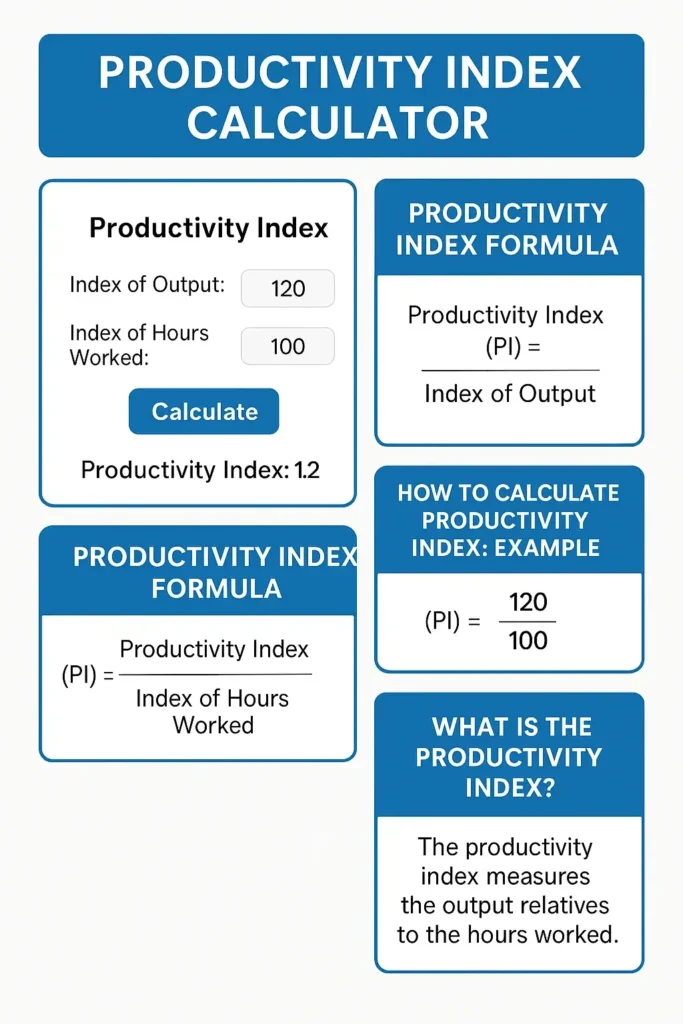Rehabilitation Productivity Calculator
Measure your rehabilitation team’s efficiency and treatment effectiveness
Other Calculators to Explore
- Productivity Calculator
- Therapy Productivity Calculator
- Sales Productivity Calculator
- Employee Productivity Calculator
- Labor Productivity Calculator
- Productivity Percentage Calculator
- Healthcare Productivity Calculator
- Rehab Productivity Calculator
Productivity Index Calculator: Measure and Enhance Operational Efficiency
Understanding and improving productivity is crucial for any organization aiming to optimize performance and achieve sustainable growth. The Productivity Index Calculator is a valuable tool that helps quantify efficiency by comparing output to input over a specific period. This metric provides insights into how effectively resources are utilized, enabling informed decision-making and strategic planning.
What Is the Productivity Index?
The Productivity Index is a ratio that measures the efficiency of production by comparing the output generated to the input used. It’s commonly used across various industries to assess performance, identify areas for improvement, and benchmark against industry standards.
Productivity Index Formula
The productivity index formula is straightforward:
Productivity Index (PI) = Index of Output / Index of Hours Worked
- Index of Output (IO): Represents the total output produced, adjusted to a base period (usually set at 100).
- Index of Hours Worked (IHW): Represents the total hours worked, also adjusted to the same base period.
This formula allows organizations to track productivity changes over time, considering both output and labor input.
How to Calculate Productivity Index: Example
Let’s consider an example to illustrate how to calculate the productivity index:
Suppose a company has the following data:
- Index of Output (IO): 120
- Index of Hours Worked (IHW): 100
Applying the formula:
PI = IO / IHW
PI = 120 / 100
PI = 1.2
A productivity index of 1.2 indicates a 20% improvement in productivity compared to the base period. This means the company is producing 20% more output per hour worked than during the base period.

Importance of the Productivity Index
Monitoring the productivity index is vital for several reasons:
- Performance Evaluation: Helps assess the efficiency of operations and identify trends over time.
- Resource Allocation: Informs decisions on allocating labor and capital to maximize output.
- Benchmarking: Allows comparison with industry standards or competitors.
- Strategic Planning: Supports long-term planning by highlighting areas needing improvement.
For a deeper understanding of productivity measurement, the U.S. Bureau of Labor Statistics provides comprehensive resources on calculating productivity.
Enhancing Productivity
Improving productivity involves various strategies, including:
- Process Optimization: Streamlining workflows to eliminate inefficiencies.
- Technology Integration: Implementing tools and systems that automate tasks and improve accuracy.
- Employee Training: Investing in skill development to enhance performance.
- Performance Monitoring: Regularly tracking metrics to identify and address issues promptly.
Final Thoughts
The Productivity Index Calculator is an essential tool for organizations aiming to measure and improve efficiency. By understanding and applying the productivity index formula, businesses can make data-driven decisions that lead to enhanced performance and competitive advantage. Regularly monitoring this metric ensures that resources are utilized effectively, contributing to overall organizational success.
